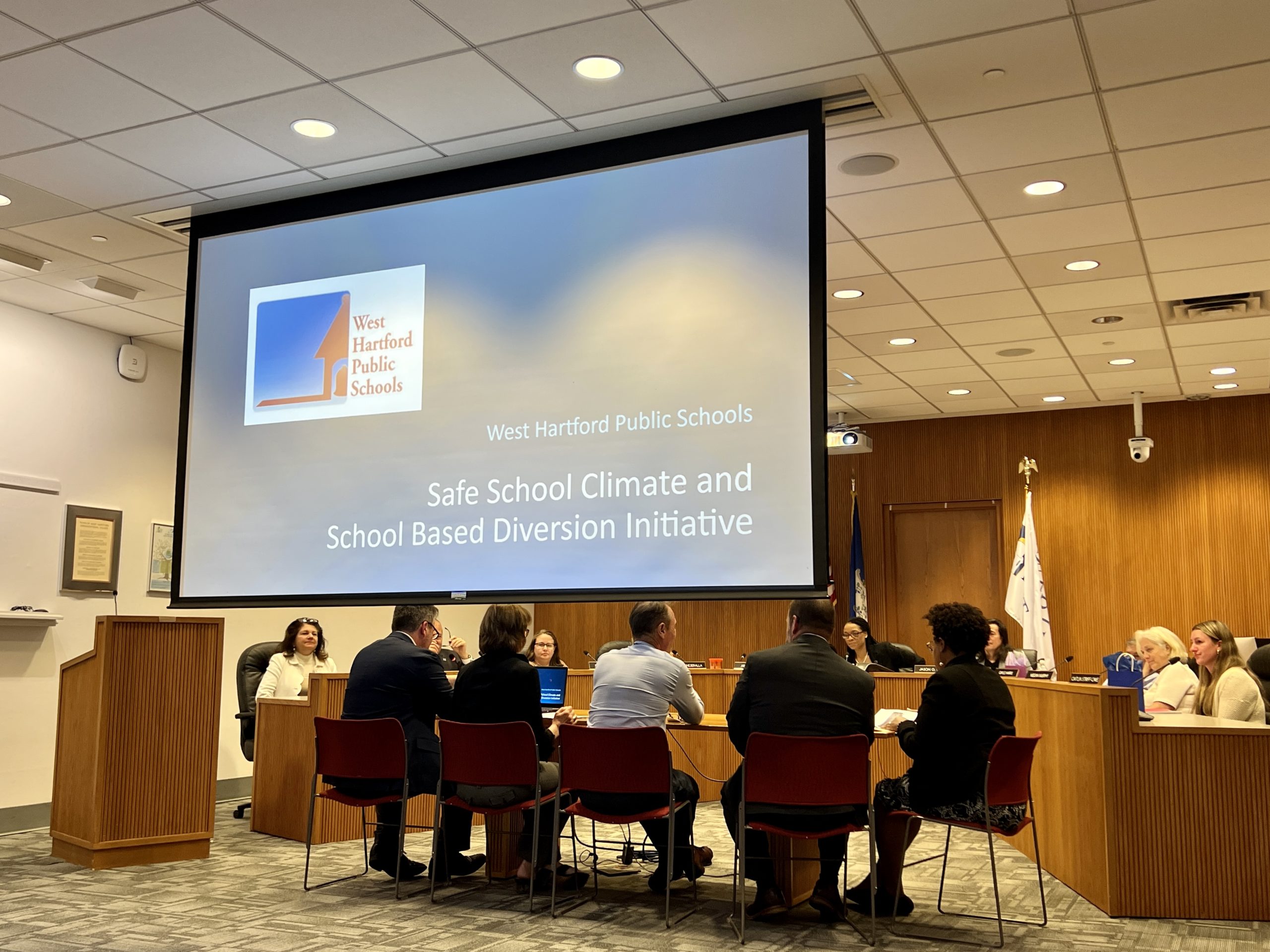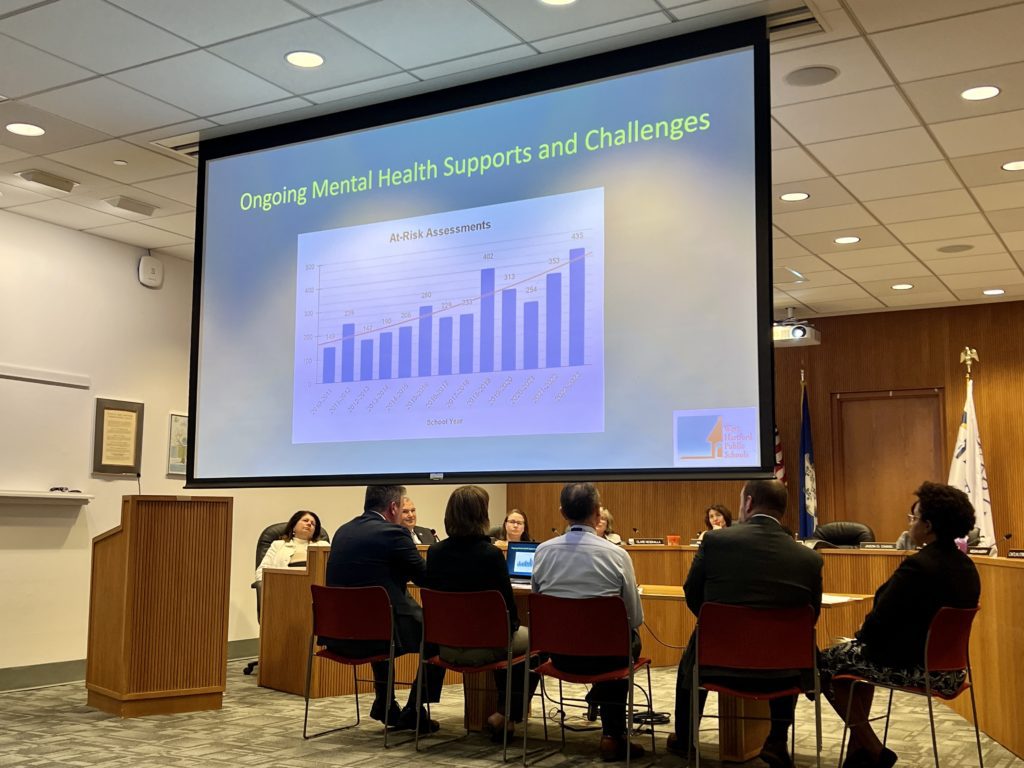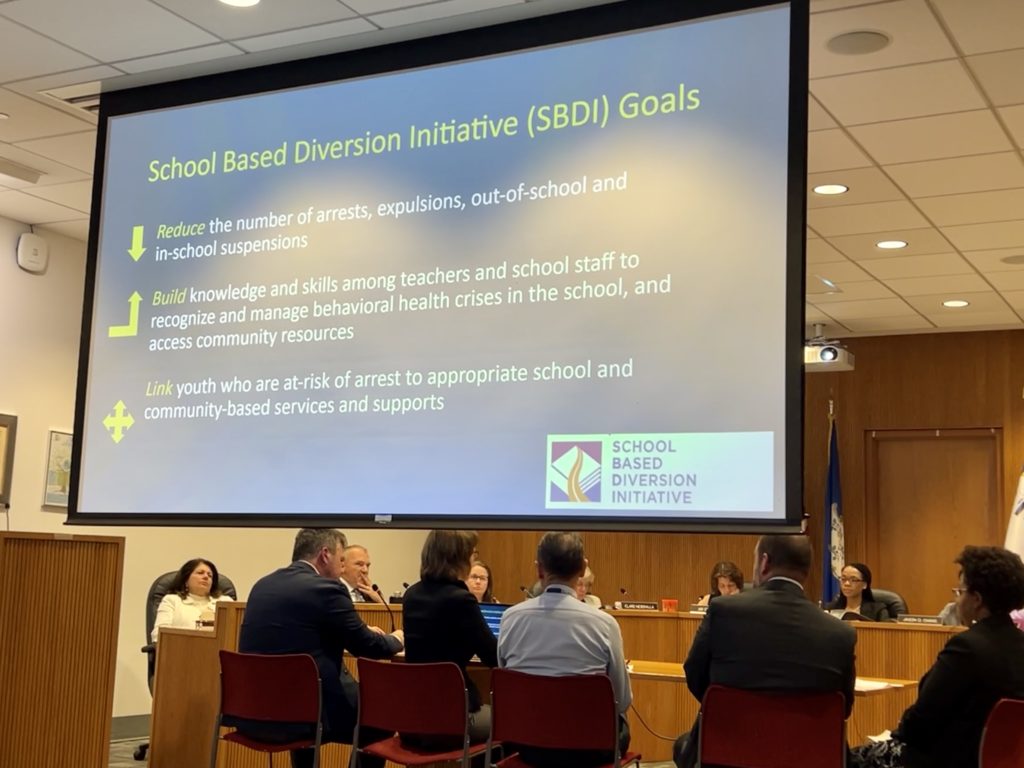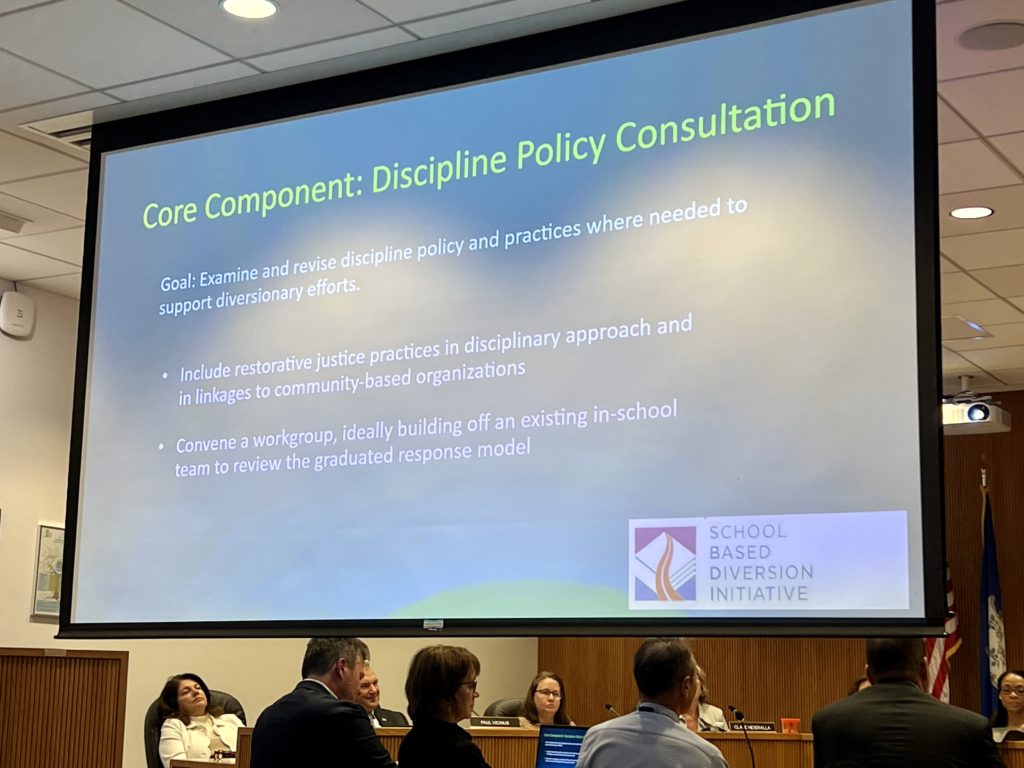West Hartford Public Schools Present Safe School Climate Report

Audio By Carbonatix

West Hartford Public Schools assistant superintendents and middle school principals presented the Safe School Climate Report to the Board of Education on June 6. Photo credit: Ronni Newton
West Hartford district leaders presented their efforts in promoting a safe school climate through the means of physical and emotional safety to the Board of Education on Tuesday night.
By Bridget Bronsdon
The West Hartford Board of Education met Tuesday for their final meeting of the 2022-2023 school year and among the discussed agenda items was the Safe School Climate Report– one of the most timely and pertinent reports to note.
The report presented included “feedback on K-12 school climate” in addition to “ongoing student safety and mental health reports.” The contents of the presentation provided insight into the “comprehensive range of district and community-based interventions” applied within the schools to meet the diverse needs of the students.
Assistant Superintendents Andy Morrow and Anne McKernan, as well as middle school principals Chad Ellis (Bristow) Juan Melian (Sedgwick), and Joy Wright (King Philip) collaboratively spearheaded this plan and presentation, which included a written report.
As the district continues to support students in all schools, as well as in the STRIVE, REACH, and Alternative Education Program (AEP), and is still assessing new ways to improve student behavior and “to engage our entire school community in ways to keep our children safe.”
Morrow said that sometimes behaviors are not always “about us as people,” but are about the situations people find themselves in.
Safe School Climate Committees, which are present in every school, lead the efforts in that particular school, and are “composed of teachers, administrators, parents, and at the high school level, students,” the report stated. The job of each respective committee, according to the report, is to examine data “from their school that speaks to the environment for students there.” Building off of that data, “each school committee looks at the results of the safe school climate committee survey to tailor specific school plans to meet each building’s needs, both for policies and for professional development.”
The West Hartford school district not only strives to maintain a high caliber of physical safety but emotional safety as well. “School safety and security starts with establishing a trusting, supportive, and safe school climate. Creating a culture where all members of the community feel connected is an essential element of the district’s approach; when students feel comfortable asking for help or reporting concerns, schools become safer,” states the report. Therefore, the district has imposed a number of mental health supports to continue to respond to the needs of the students.
The first of those supports is the Social and Emotional Learning Program. This targeted lesson is aimed at “developing a positive self-image, strengthening self-management skills, examining conflict resolution approaches, learning proactive communication, and understanding responsible decision making, among other skills.” Through these inclusive lessons, the district aims to “promote prosocial behavior, and assists students in making connections with school staff and their peers.”
School counselors and clinical staff are also receiving “training in a variety of areas including trauma-informed practices.” On top of this, the district has added “additional staff trained in counseling and mental health support including five elementary school counselors, three social workers, two middle school counselors, a student mental health coordinator, a trauma interventionist, and a home-to-school liaison.”
Building off of these efforts, the district has included “various risk assessment tools to evaluate threats.” One of these tools, Proactive Risk Assessment (PRAT) is designed to respond to threats made to the school, community, or another person. “The PRAT is completed by a trained and certified behavior specialist who utilizes available information regarding risk factors, warning signs, and stabilizing factors to arrive at a categorical description of risk for a particular point in time.”
Another organization that the West Hartford Public Schools has partnered with is the Sandy Hook Promise to bring two new programs into the district. Both programs are provided at no cost.
Start with Hello “teaches students to be more socially inclusive and connected to each other. The goal of the program is to end social isolation.” The second program, Say Something, “includes lessons on how to empathize with others, seek help when needed, identify problems and analyze situations in an ethically-responsible manner.”
In addition to partnering with programs and organizations, the distinct has also adopted new technology to aid in responding to alerts and threats, the report states.
Anonymous Alerts is a technology designed for anyone who sees a dangerous situation to anonymously report it and alert school staff. “The technology is designed to provide two-way communication allowing school staff to acknowledge receipt of the message and request more information if needed.” One of the key features of this technology is anonymity which “encourages those who feel vulnerable to speak up without fear of reprisal.”

West Hartford Public Schools assistant superintendents and middle school principals presented the Safe School Climate Report to the Board of Education on June 6. Photo credit: Ronni Newton
At the same time, it is also critical for the West Hartford schools to be able to track student needs. The At-Risk Suicidal Ideation and Self Harm Risk Assessments are ways in which the district is able to monitor student needs. Through these measurements, administrators are able to learn more about what students require emotionally.
McKernan told the Board that she became aware of the opportunity to apply for a grant for school-based diversion initiatives which could be used to link students with appropriate supports. Middle school was determined to be the best place to start – and she successfully applied for and received the grant last summer to be used during the 2022-2023 academic year.

West Hartford Public Schools assistant superintendents and middle school principals presented the Safe School Climate Report to the Board of Education on June 6. Photo credit: Ronni Newton
The grant, from the Connecticut State Department of Education, has facilitated the ability to bring the School Based-Diversion Initiative (SBDI) program and restorative practice training to the district’s three middle schools.” The SBDI program is designed to “keep students in school, improve student outcomes, and ensure that students receive fair and equitable in-school discipline with a particular focus on restorative practice.”
According to the report, “Restorative practices focus on resolving conflict, repairing harm, and healing relationships. Through these practices, schools are able to strengthen their community and reduce exclusionary practices such as arrests, expulsions, and out-of-school suspensions.” Through the grant, a Teacher-Leader in Residence (LIR) at each school – or in the case of King Philip co-leaders – were assigned to spearhead the initiative in their particular school.

West Hartford Public Schools assistant superintendents and middle school principals presented the Safe School Climate Report to the Board of Education on June 6. Photo credit: Ronni Newton
The grant included funds for professional training, and each school utilized the funding in the following ways.
Melian noted that Sedgwick initiated a Restorative Lunch Program which allows students who have trouble following appropriate school behaviors to meet with the clinical staff for a two-week stretch during their lunch period.
“Clinicians help students to better understand how their actions affect the entire Sedgwick community. At the conclusion of the two weeks, participants who have shown appropriate growth and understanding are challenged to speak with anyone they harmed and offer an apology,” according to the report.
Sedgwick also created a Restorative Justice Space in the building where clinicians and students could have a safe meeting space to talk through actions and then understand the consequences. The room was equipped with teaching resources as well as furnishings to create a comfortable environment amenable to group discussion as well as privacy.
As for King Philip, administrators “trained all para educators and teaching assistants in the restorative principles and practices.” In a similar manner to Sedgwick, KPM also created a Restorative Justice Space in their building.
Bristow used the funds in part to finance a program with world champion athlete, Chris Poulos, who led three assemblies. The goals were to celebrate joy and fun, and also to understand the “importance of having core values, setting and achieving goals, and learning from the lessons life offers.”
Bristow also created a mindfulness center – a space in the building where students can go to calm down, relax, and talk through their feelings with a trusted adult, and funded a training program with a representative from the International Institute of Restorative Practice to “to lead the staff in understanding the social discipline window” and properly set expectations.
“Pre-storative work is really starting a baseline,” Ellis said.

West Hartford Public Schools assistant superintendents and middle school principals presented the Safe School Climate Report to the Board of Education on June 6. Photo credit: Ronni Newton
Wright said this is just the beginning of the process of using the program effectively, to determine the best consequences to get students to know better so that they will be able to do better. “It takes time to have conversations with students and talk about ‘What did I do wrong?’” she said.
McKernan said one of the advantages of this type of approach is that each school has the ability to implement the program in its own way. The middle school principals were supportive of applying for the grant again, which she plans to do, and following these experiences and the implementation of new spaces and training in the middle schools, the district high schools have now submitted an SBDI application for the 2023-2024 school year.
Like what you see here? Click here to subscribe to We-Ha’s newsletter so you’ll always be in the know about what’s happening in West Hartford! Click the blue button below to become a supporter of We-Ha.com and our efforts to continue producing quality journalism.



